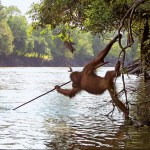ape
The skeletons of Lucy (left) and Kadanuumuu (right). Both belong to the early human species Australopithecus afarensis. (Images not to scale.)
I never fully appreciated how small Lucy was until I saw her bones for myself. Photographs and restorations of her and her kin within the species Australopithecus afarensis had never really given me a proper sense of scale, and when I looked over her incomplete skeleton - formally known as specimen A.L. 288-1 - I was struck by her diminutive proportions. In life she would have only been about three and a half feet tall. Her physical stature seemed…
Three-dimensional models of hominoid skulls used in the study - (a) Hylobates lar; (b) Pongo pygmaeus; (c) Pan troglodytes; (d) Gorilla gorilla; (e) Australopithecus africanus; (f ) Paranthropus boisei; (g) Homo sapiens. They have been scaled to the same surface area, and the colors denote areas of stress (blue = minimal stress, pink = high stress). From Wroe et al, 2010.
It is all too easy to think of human evolution in linear terms. From our 21st century vantage point we can look back through Deep Time for the first glimmerings of the traits we see in ourselves, and despite what we have…
"Dinah", a young female gorilla kept at the Bronx Zoo in 1914. From the Zoological Society Bulletin.
Frustrated by the failure of gorillas to thrive in captivity, in 1914 the Bronx Zoo's director William Hornaday lamented "There is not the slightest reason to hope that an adult gorilla, either male or female, ever will be seen living in a zoological park or garden." Whereas wild adult gorillas were "savage" and "implacable" beasts which could not be captured (a photo of a sculpture included in Hornaday's article depicts a gorilla strangling one man, brandishing another about with its other…
A young lowland gorilla (Gorilla gorilla), photographed at the Bronx Zoo.
Today is the big day!
And not merely because it is TGIF* day.
The theme "everything you know is sort of wrong" is familiar to readers on this blog. It is an underlying theme for much of what happens here. Every now and then that theme is manifest overtly, as in the Falsehoods posts, which are, as we speak, being revised, expanded, and reissued.
Well, starting this evening and running for an indeterminate amount of time (but probably a few weeks or so) "Everything you know is sort of wrong" is not just a phrase to keep in your head all the time as you are walking around doing stuff. It's…
What is culture? One simple definition might be: a distinctive behavior shared by two or more individuals, which persists over time, and that ignorant individuals acquire through socially-aided learning.
There are at least four different ways to learn a particular behavior or problem-solving strategy. That is to say, there are four different ways to learn. The first is social facilitation, in which one individual does the same thing as the demonstrator at the same time. Essentially this is a situation of on-line matching of motor actions. For example, I might learn the steps to a complicated…
The partial faces of Anoiapithecus (left), Pierolapithecus (center), and Dryopithecus (right). (Images not to scale)
Our species is just one branch of a withering part of the evolutionary tree, the great apes. Along with the handful of species of chimpanzees, gorillas, and orangutans, we are all that is left of the hominids, and considering the threats our close relatives face we could very soon be the only great apes left. It has not always been this way. During the swath of prehistory ~23-5 million years ago known as the Miocene a variety of ape species inhabited forests through much of…
Bonobos (Pan paniscus) at Frankfurt Zoo, Germany. Joachim S. Müller / Creative Commons
... and made a real mess of the place when one of them spotted the jar of pickles on the counter. They fought over it until one of them had almost all the pickles and the other one had a number of bruises and a tiny fragment of one pickle that the other chimp dropped by accident.
That would be the way it would happen if two chimps walked into a bar. Or imagine two chimps, and each finds a nice juicy bit of fruit out in the forest. And instead of eating the fruit, because they are not hungry, they carry it around for a while (this would never happen, but pretend) and then accidentally run…
What the heck has this world come to? All over the internet, this picture of an Orangutan trying to fish with a stick has been shown:
But what's the story behind this? Is this evidence that humans are not unique among the Great Apes as tool-users?
Not quite. According to the Daily Mail, this is an orangutan that had extensive exposure to humans; this jungle setting is actually where they reintroduce orangutans into the wild from zoos, private homes and (yikes) butcher shops. This particular orangutan actually doesn't successfully know how to fish; this was something he copied from nearby…
In 1978, a paleoanthropological team including Mary Leakey, Richard Hay, and Tim White made a startling discovery at Laetoli, Tanzania; in a bed of volcanic ash that would later be dated to about 3.5 million years old were the footprints of ancient hominids. The preserved trackway, found to contain the footprints of three individuals of the same species walking in the same direction during a very short period of time (possibly walking together as a group), would become one of the most important and iconic of hominid fossils, the fact that hominids were walking upright 3.5 million years ago…

